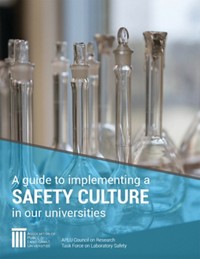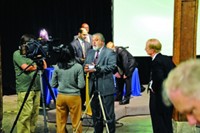Advertisement
Grab your lab coat. Let's get started
Welcome!
Welcome!
Create an account below to get 6 C&EN articles per month, receive newsletters and more - all free.
It seems this is your first time logging in online. Please enter the following information to continue.
As an ACS member you automatically get access to this site. All we need is few more details to create your reading experience.
Not you? Sign in with a different account.
Not you? Sign in with a different account.
ERROR 1
ERROR 1
ERROR 2
ERROR 2
ERROR 2
ERROR 2
ERROR 2
Password and Confirm password must match.
If you have an ACS member number, please enter it here so we can link this account to your membership. (optional)
ERROR 2
ACS values your privacy. By submitting your information, you are gaining access to C&EN and subscribing to our weekly newsletter. We use the information you provide to make your reading experience better, and we will never sell your data to third party members.
Safety
School Labs Go Under Microscope
Laboratory accidents in academia to be investigated by chemical safety board
by Jeff Johnson
February 1, 2010
| A version of this story appeared in
Volume 88, Issue 5
Mary Beth Mulcahy is one of two Chemical Safety & Hazard Investigation Board (CSB) investigators who this month will examine a chemistry department laboratory accident at Texas Tech University. It is the first investigation the safety board has ever done of a school lab accident, and safety experts tell C&EN it is long overdue.
The Jan. 7 accident at the Lubbock, Texas, campus put a 29-year-old student into critical condition at a hospital burn unit, where he remains. Preston Brown’s research was part of a Department of Homeland Security (DHS) contract to study explosives.
It is unclear how common university accidents like this one are since there are no systematic academic lab accident records. But every lab rat has a story, including Mulcahy.
On a Saturday afternoon in the fall of 2001, she was hard at work at a University of Colorado chemistry lab bench, wrapping up an experiment and putting away her equipment. It was her second year as a chemistry department graduate student at the Boulder campus.
“I was cleaning my glassware with ethanol and nitric acid,” she recalls to C&EN. It was a technique she’d learned from another graduate student who learned it from a postdoc who had come from Germany. She put the mixture in a waste bottle and began taking off her protective clothing and goggles.
“I thought I was done with the reaction when the bottle detonated. I got acid burns on my body and face, and glass blasted through my clothing and was embedded in my side. It cut a nerve in my elbow. It was messy,” she says.
Shocked, she ran into the hall, yelling, and then hustled into the shower. “Nitric acid is a slow burn,” she says. “You don’t feel it right away but when you do, it really burns.”
An alarm went off and the fire department arrived quickly and tried to set up a personal, private area for her to shower, but she wasn’t waiting. She took a fast scrub, slipped on the fire department’s Tyvek suit, and was taken by an ambulance to a nearby hospital. She wound up with stitches and burns, but didn’t need surgery.
There was never a thorough investigation, she says. It merited a brief announcement in the Boulder newspaper since the alarm led to a building evacuation.
Mulcahy was using an old, but common technique, she says, and “one that others in my lab were also using. There were even references to it online.” Her adviser was unaware students were using the practice and ended it after her accident.

Mulcahy points out that many graduate students and faculty can tell a story about their near-miss. There is a tension, many interviewed for this story tell C&EN, between the rush and excitement of student-led experiments and the considerations needed to ensure safety. Mulcahy said this dichotomy will be examined as part of CSB’s investigation.
“Laboratory inbreeding” is James A. Kaufman’s term for the root cause of accidents like Mulcahy’s. If schools lack a mandatory, formal lab safety training program, he says, the rite of passage into the lab for a new student researcher is to be taught lab practices by a more experienced grad student, and that, he says, is a big problem.
“Those graduate students eventually become faculty, and they never step out of the loop,” says Kaufman, who is president and chief executive officer of the Laboratory Safety Institute, a Massachusetts-based lab safety training and education organization.
For over 35 years, Kaufman has collected information about more than 5,000 university and high school lab accidents. He estimates that academic lab accidents occur on a man-hour basis 10 to 50 times more frequently than chemical plant accidents.
His first job was at a Dow Chemical lab, where he spent the first day with his boss who talked about nothing but safety, Kaufman says. “I thought I must have gone to work at the most dangerous place in the world,” he says. “I am going to die,” he recalls thinking.
Two weeks later, the lab had an explosion and fire that cleared the place, but no one was hurt. And then two weeks after that, an accident and explosion took place at his alma mater, Worchester Polytechnic Institute. “A graduate student was hurt who was doing six things I learned not to do at Dow during my first day. I visited the lab and saw broken-out windows, benches destroyed—and a student was crippled for life. Right then, I decided I would share my experience at Dow with schools.”
Kaufman went on to prepare and publicize lab safety information for most of his life, often through American Chemical Society programs and workshops at national meetings.
He applauds CSB’s decision to investigate Texas Tech, and for a decade, he says, he has urged the board to comprehensively examine high school and college lab accidents. “We have to change the paradigm where faculty and students say they never have had an accident, so why make such a big deal out of it?” He says they don’t have statistics and they simply don’t know.
It isn’t a problem just at universities, Kaufman notes. A few weeks ago, on Jan. 19, an explosion ripped through a chemistry lab at Onteora High School, in Boiceville, N.Y., injuring seven students and their teacher. He also points to a much-cited and tragic chemistry class accident involving a methanol flash fire at Western Reserve Academy in Hudson, Ohio, in 2006. Eight people were injured, including two badly burned students and their chemistry teacher, as well as her nine-year-old son who was helping that day.
Getting a national perspective on the frequency and cause of school accidents could grow from the CSB investigation at Texas Tech, says CSB Chairman John S. Bresland. Depending on what the board turns up at Texas Tech, he says, CSB may embark on an examination of U.S. academic lab safety, which could happen next fall (C&EN, Jan. 25, page 7).
The board, Bresland says, has begun taking notice of school lab accidents, such as the tragic fatality a year ago at UCLA (C&EN, Aug. 3, 2009, page 29).
CSB searches for the root cause of chemically related accidents and has issued some 60 reports on accidents at industrial and distribution facilities. It has never investigated a school lab accident.
According to CSB, the injured Texas Tech student received severe burns and lacerations to his face and hands when a mixture of nickel hydrazine perchlorate exploded during the afternoon accident in the chemistry building. University officials told CSB the accident involved the detonation of a high-energy metal compound, most likely [Ni(N2H4)3][ClO4]2. Texas Tech, the board reported, has an agreement with Northeastern University to study high-energy materials for DHS.
In a statement, Texas Tech Vice President for Research Taylor Eighmy said, “We appreciate the opportunity to collaborate with the U.S. Chemical Safety Board on the investigation of this incident. We look forward to completing our own internal investigation. Texas Tech is committed to safe practices and procedures. We have an excellent program in place, yet we believe this incident affords us an opportunity to proactively look at our safety training.”
In an interview with C&EN, Eighmy would not comment on the accident’s cause or lab damage, or provide information on the student, other than he was a graduate student and university employee. The university, he adds, will conduct its own investigation.
Texas Tech has “a very rigorous lab training program,” he continues, but Eighmy would not comment on whether Brown had gone through the program, saying only “that is part of our investigation.”
He adds that the federal Occupational Safety & Health Administration does not have jurisdiction at the university, and it was unclear if any state agencies would investigate. The question of what government bodies, federal and state, investigate school accidents is one of the issues CSB will examine, notes CSB investigations supervisor Don Holmstrom, who along with Mulcahy will conduct the board’s investigation.
The board also will look at the responsibility of granting agencies for accidents that occur under their contracts as well as the employment status of experimenters—that is, are they students, postdocs, graduate students, or employees.
“This investigation will be very interesting,” says Russell W. Phifer, safety consultant and past chair of ACS’s Division of Chemical Health & Safety and its Committee on Chemical Safety. There is a need to improve the safety practices and culture at many university labs, he says.
“Maybe publicizing this particular investigation will wake up other institutions to the need to start paying attention and not lose track of the fact that there are hazardous materials and equipment in labs,” he says.
A huge difference exists, he says, between university and industry labs. “There are industrial labs where the first time you are caught not wearing appropriate eye protection, you’re fired. That would never happen in an academic lab. It is a difference in culture,” Phifer says.
But there are rare instances where safety violations in academic labs have had ramifications. For example, a chemistry faculty member was fired at the University of Texas, San Antonio, in 2002 over safety issues, including unsafe chemical storage (C&EN, March 18, 2002, page 39).
Phifer and Kaufman add that there is a strong need to educate principal investigators and university deans on the importance of safety. “By and large, grant production and money is what it is all about for many PIs, not all, but many. Work is the number one priority, and I think it should be safety,” Phifer says.
He notes that there will be a presidential symposium on laboratory safety in academic institutions at the fall 2010 ACS national meeting in Boston. He hopes the symposium helps elevate lab safety among ACS members.





Join the conversation
Contact the reporter
Submit a Letter to the Editor for publication
Engage with us on Twitter